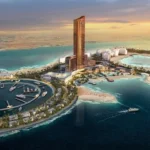Now Reading: Transit Hubs Real Estate Impact: Shaping the Future
-
01
Transit Hubs Real Estate Impact: Shaping the Future
Transit Hubs Real Estate Impact: Shaping the Future

Transit hubs real estate impact is becoming one of the most important forces in shaping how cities expand and how property values change. Around the world, airports, metro networks, and railway stations are not only moving millions of people every day but also influencing where developers invest and where residents choose to live.
In places like the UAE, London, Singapore, and New York, new transport infrastructure is redefining real estate growth. From luxury apartments near metro stations to commercial hubs around airports, the link between transport and property has never been stronger.
This article explores the role of transit hubs in real estate, the opportunities they create for investors, and the risks that come with such rapid growth.
What Makes a Transit Hub?
Transit hubs are large centers where multiple transport modes connect. These can include:
- Airports – international gateways that bring tourists and business travelers.
- Railway stations – high-speed rail and intercity lines connecting key regions.
- Metro interchanges – where several urban train lines meet.
- Bus and logistics terminals – important for moving people and goods.
A successful transit hub is not just about transport. It is also about how the surrounding real estate is planned. Cities that integrate housing, retail, and business around these hubs often see faster economic growth.
Transit Hubs as Real Estate Catalysts
The link between transit and real estate is clear: better connectivity raises land values. Property developers and investors recognize that areas near major transport hubs enjoy:
- Higher demand for residential units – commuters prefer living close to transit lines.
- Premium office rents – companies pay more for locations with easy employee access.
- Retail growth – shopping malls and restaurants thrive in high-footfall areas.
- Mixed-use projects – combining housing, offices, hotels, and leisure near stations.
Studies show that properties within walking distance of metro or rail stations can sell for 10–30% more compared to similar units further away.
Global Examples of Transit Hubs Driving Real Estate
London – The Elizabeth Line Effect
London’s Crossrail project, also known as the Elizabeth Line, has completely reshaped property markets. Before the line even opened in 2022, property prices along the route surged as buyers anticipated faster connections to central London. Developers launched new residential towers and commercial complexes around stations like Canary Wharf and Tottenham Court Road.
New York – Penn Station Redevelopment
Penn Station, one of the busiest in the U.S., is undergoing a massive transformation. The redevelopment aims to modernize the station and revitalize the entire Midtown Manhattan area. Already, new office towers and luxury apartments are planned around the site, showing how transit improvements can revive aging neighborhoods.
Singapore – Changi Airport Expansion
Changi Airport is not only one of the world’s best airports but also a hub for real estate activity. The expansion of Terminal 5 and new airport-linked business parks are attracting international companies. Hotels, logistics parks, and housing are all benefiting from the airport’s constant growth.
Dubai – Metro and Airport Expansion
Dubai has become a global leader in linking transit and real estate. The Dubai Metro’s Red and Green Lines have boosted property values along their routes. Areas such as Dubai Marina, Business Bay, and Expo City Dubai owe much of their success to nearby metro access. Dubai International Airport and Al Maktoum International Airport also anchor logistics and tourism-driven developments.
The UAE Context: A Future Shaped by Transit
The UAE is investing heavily in transport infrastructure. Two projects stand out:
- Etihad Rail – A nationwide rail network that will link the seven emirates and connect to neighboring GCC countries. Real estate along its corridors is expected to benefit, with industrial zones, residential projects, and logistics hubs growing near key stations.
- Dubai Metro Expansion – Plans for new lines, including extensions to connect more residential communities, are already sparking real estate activity. Developers see opportunities in areas that were once considered too far from the city center.
Developers like Emaar, Aldar, and Nakheel are aligning projects to benefit from these hubs, building integrated communities that blend housing, retail, and business with easy transport access.
How Transit Hubs Influence Commercial Real Estate

Transit hubs are magnets for commercial development. Office buildings near metro lines or airports attract multinational firms. Logistics companies choose sites close to rail and airport cargo hubs. Hotels thrive around major transport gateways.
For example:
- Business districts near Dubai International Airport cater to companies with global clients.
- Warehouses and logistics parks near Etihad Rail will reduce transport costs and improve supply chain efficiency.
- Shopping malls connected to metro stations enjoy higher foot traffic and sales.
The result is a cycle where transport drives business, and business growth demands more real estate.
Residential Impact of Transit Hubs
For residents, transit hubs mean convenience and better lifestyle choices. Living near a metro station or rail line reduces commuting time, which is a strong selling point for buyers and renters.
However, this demand often comes at a price. Properties near major transit hubs usually cost more. In Dubai, apartments within a 10-minute walk of a metro station are consistently priced higher than similar units further away.
On the other hand, affordable housing near transit is also in demand. Developers are now experimenting with mixed-income communities close to transport to attract a wider buyer base.
Sustainability and Smart Cities
Transit hubs also play a role in sustainability. As governments push for reduced car use, transit-oriented development (TOD) becomes more important. By encouraging people to live, work, and shop near transport lines, cities reduce traffic congestion and lower carbon emissions.
In smart city planning, real estate and transit are integrated. Sensors, digital ticketing, and AI-driven traffic management ensure smooth mobility, while real estate projects include green spaces, energy-efficient buildings, and smart home technology.
Challenges and Risks
While the transit hubs real estate impact is largely positive, there are risks:
- Over-speculation – Developers may overbuild near transit hubs, leading to supply-demand imbalance.
- Congestion – Areas around busy stations may face overcrowding and traffic problems.
- High costs – Infrastructure projects are expensive and require long-term planning.
- Gentrification – Rising property prices can push out lower-income residents.
Cities must balance growth with sustainability and affordability to ensure long-term benefits.
The Future Outlook
Looking ahead, transit hubs will remain at the heart of urban development. Airports will grow into full-fledged “aerotropolises” – cities around airports. Metro and rail networks will define where new communities are built. Digital and green technologies will make transit-oriented real estate more efficient and sustainable.
In the UAE, the combination of Etihad Rail, Dubai Metro expansion, and new airport projects will ensure that transport continues to shape real estate markets for decades. Developers, investors, and governments who align with these trends will enjoy strong growth opportunities.
Conclusion
Transit hubs real estate impact is more than just a trend – it is a driving force behind the future of cities. From London to Dubai, from Singapore to New York, transit and property development are now inseparable.
For investors and developers, the message is clear: follow the transit lines, and you will find the next wave of real estate growth. For residents, living near transit hubs offers convenience, lifestyle, and long-term value.
The future of real estate is moving fast, and it is moving along the tracks, runways, and metro lines of the world’s transit hubs.
Follow us on: Instagram






















